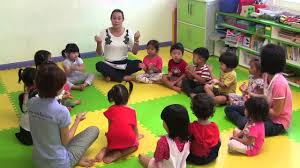 BACKGROUND: Circle time provides a prime opportunity for building young children’s academic and social skills (Benedict, Horner, & Squires, 2007). However, challenging behaviors that often arise during circle time may frustrate teachers. Although challenging behaviors can occur during any circle time activity (e.g., calendar, book reading, songs, discussions) they are most likely to occur during activities that offer little opportunity for children to actively participate (Zaghlawan & Ostrosky, 2011). It is important that teachers plan ahead for circle time to engage children and reduce challenging behaviors.
BACKGROUND: Circle time provides a prime opportunity for building young children’s academic and social skills (Benedict, Horner, & Squires, 2007). However, challenging behaviors that often arise during circle time may frustrate teachers. Although challenging behaviors can occur during any circle time activity (e.g., calendar, book reading, songs, discussions) they are most likely to occur during activities that offer little opportunity for children to actively participate (Zaghlawan & Ostrosky, 2011). It is important that teachers plan ahead for circle time to engage children and reduce challenging behaviors.
AUTHORS: Halle DuMoulin, Early Childhood Specialist, Sophie Rogers School for Early Learning; Kristin S. Farley, Doctoral Candidate, Crane Center for Early Childhood Research and Policy
Strategies for successful planning
- Have age-appropriate expectations for the length of circle time and for children’s movement. Circle time should initially be short; it can gradually become longer throughout the year.
- Establish a routine and clear expectations for circle time; review the expectations at the beginning of circle.
- Prepare activities and materials ahead of time, but be willing to adapt the plan based on children’s needs.
Strategies for engaging children
- Begin with a large motor activity (e.g., jumping jacks) to help focus children’s attention.
- Alternate large motor activities and songs with listening activities (e.g., book reading).
- Offer chances to hold and manipulate materials related to the book or conversation
APPLICATION: In the scenarios below, Halle addresses challenging behaviors and adjusts morning circle time.
Over the next few days, Halle and her co-teachers reflected on what difficulties were occurring at circle time. They decided that circle time may involve too much sitting, and that incorporating a large motor activity may help engage the children. They also decided to split their circle into 2 sessions, lasting 5-7 minutes each. Halle is leading circle time in her preschool class. They have already spent approximately 15 minutes discussing the calendar, weather, and activities for the day. After these daily routines, she tries to read a short story before students are dismissed to small group work. Halle noticed that students were off task during the story, and she is unable to finish reading. She dismisses the students to their small group work for the day. The next day, a similar problem occurs.
The next day, they begin with a brief circle time where they briefly reminded children of the expectations for circle time, then danced and sang to a short song, followed by discussing their activities for the day. After this circle, students completed small group work and then gathered at circle for a second time to discuss the calendar and weather. While talking about calendar, Halle incorporated a large motor activity by having students do 27 jumping jacks for the 27th day of January. After calendar, she read a short story and dismissed the students to free play. During both circle time sessions, Halle and her co-teachers observed children actively participating, needing fewer reminders of the expectations for circle time.
TO LEARN MORE:
10 Tips for Circle Time
Making Circle Time Successful
REFERENCES:
Benedict, E.A., Horner, R.H., & Squires, J.K. (2007). Assessment and implementation of positive behavior support in preschools. Topics in Early Childhood Special Education, 27(3), 174-192.
Zaghlawan, H.Y. & Ostrosky, M.M. (2011). Circle time: An exploratory study of activities and challenging behavior in Head Start classrooms. Early Childhood Education Journal, 38, 439-448.
Successful Circle Times with Young Children
Other Resources
https://teachpreschool.org/2013/03/25/ten-tips-for-circletime/
https://teachmetotalk.com/2011/02/15/making-circle-time-successful/
https://crane.osu.edu/files/2020/01/Successful-Circle-Times-with-Young-Children.pdf

